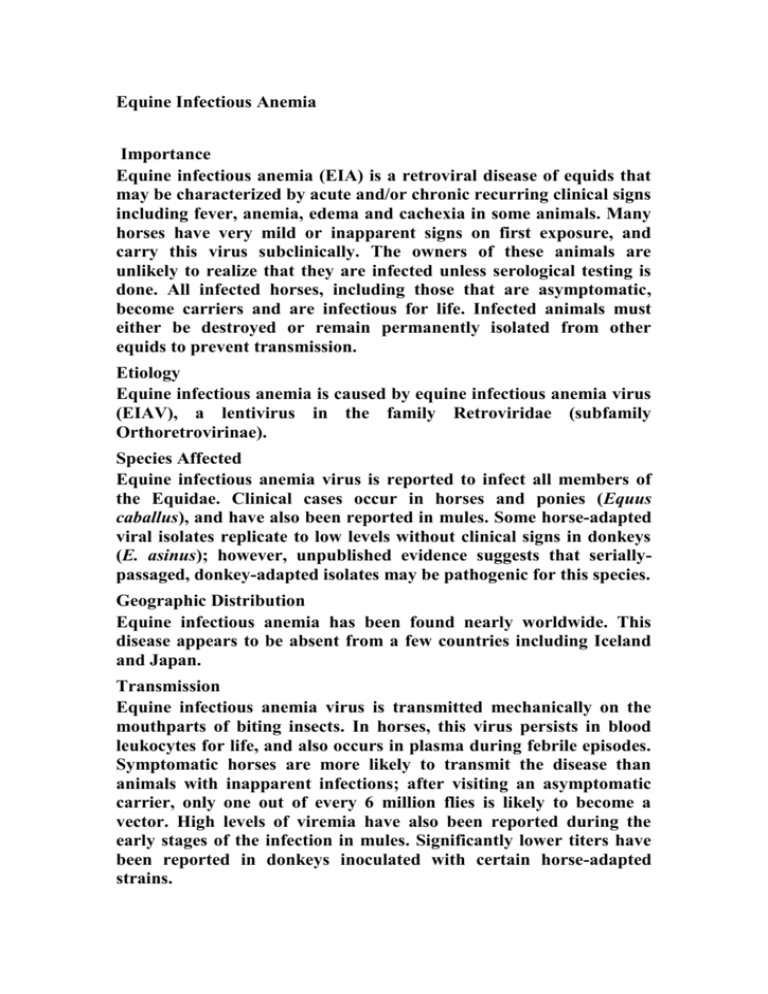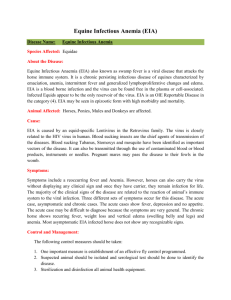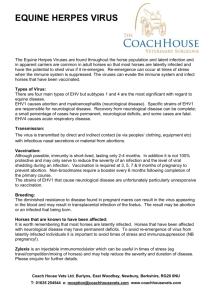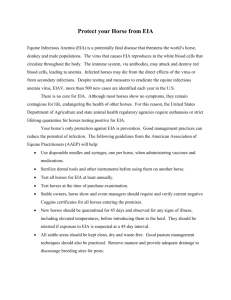Equine Infectious Anemia Importance Equine infectious anemia (EIA
advertisement

Equine Infectious Anemia Importance Equine infectious anemia (EIA) is a retroviral disease of equids that may be characterized by acute and/or chronic recurring clinical signs including fever, anemia, edema and cachexia in some animals. Many horses have very mild or inapparent signs on first exposure, and carry this virus subclinically. The owners of these animals are unlikely to realize that they are infected unless serological testing is done. All infected horses, including those that are asymptomatic, become carriers and are infectious for life. Infected animals must either be destroyed or remain permanently isolated from other equids to prevent transmission. Etiology Equine infectious anemia is caused by equine infectious anemia virus (EIAV), a lentivirus in the family Retroviridae (subfamily Orthoretrovirinae). Species Affected Equine infectious anemia virus is reported to infect all members of the Equidae. Clinical cases occur in horses and ponies (Equus caballus), and have also been reported in mules. Some horse-adapted viral isolates replicate to low levels without clinical signs in donkeys (E. asinus); however, unpublished evidence suggests that seriallypassaged, donkey-adapted isolates may be pathogenic for this species. Geographic Distribution Equine infectious anemia has been found nearly worldwide. This disease appears to be absent from a few countries including Iceland and Japan. Transmission Equine infectious anemia virus is transmitted mechanically on the mouthparts of biting insects. In horses, this virus persists in blood leukocytes for life, and also occurs in plasma during febrile episodes. Symptomatic horses are more likely to transmit the disease than animals with inapparent infections; after visiting an asymptomatic carrier, only one out of every 6 million flies is likely to become a vector. High levels of viremia have also been reported during the early stages of the infection in mules. Significantly lower titers have been reported in donkeys inoculated with certain horse-adapted strains. Although other insects including stable flies (Stomoxys calcitrans) can transmit EIAV, the most effective vectors are biting flies in the family Tabanidae, especially horse flies (Tabanus spp. and Hybomitra spp.) and deer flies (Chrysops spp.). The bites of these flies are painful, and the animal’s reaction interrupts feeding. The fly attempts to resume feeding immediately, either on the same animal or on another nearby host, resulting in the transfer of infectious blood. EIAV survives for a limited time on the mouthparts of insects, and it is less likely to be spread to more distant hosts. This virus can also be transmitted in blood transfusions or on contaminated needles, surgical instruments and teeth floats. It is reported to persist for up to 96 hours on hypodermic needles. EIAV may also be passed from a mare to her foal in utero. Other, minor routes of transmission might be possible. EIAV does not appear to be shed in saliva or urine. However, it can be found in milk and semen, and horses can be infected by inoculating these secretions subcutaneously. Possible transmission through milk has been reported in some nursing foals. Although venereal transmission does not seem to be a major route of spread, one stallion appears to have transmitted the virus to a mare with a vaginal tear during breeding. The possibility of aerosol transmission by infectious material during close contact was raised during the 2006 outbreak in Ireland. Incubation Period The incubation period is a week to 45 days or longer. Some horses remain asymptomatic until they are stressed. EIA_A2009 © 2009 CFSPHEquine Infectious Anemia Last Updated: August 2009 © 2009 CFSPH page 2 of 4 Clinical Signs The clinical signs of acute EIA are often nonspecific. In some cases in horses, the only sign is a fever, which is sometimes accompanied by transient inappetence. In mild cases, the fever can last less than 24 hours. More severely affected horses can become weak, depressed and inappetent, with additional signs that may include jaundice, tachypnea, tachycardia, ventral pitting edema, thrombocytopenia, petechiae on the mucus membranes, epistaxis or blood–stained feces. Anemia can occur, although it is more likely to be severe in chronically infected animals. Occasionally, horses become gravely ill and may die during the acute stage. After the initial bout, most horses become asymptomatic carriers; however, some animals develop recurring clinical signs that vary from mild illness and failure to thrive to fever, depression, petechial hemorrhages on the mucus membranes, weight loss, anemia and dependent edema. Inapparent infections may become symptomatic during concurrent illnesses, severe stress or hard work. Death is possible during these febrile episodes. Ophthalmic lesions, characterized by depigmentation with prominent choroidal vessels, have been reported in chronically infected horses. Donkeys and mules are less likely to develop severe clinical signs. Mules can be infected asymptomatically, but typical EIA signs have been reported in some naturally or experimentally infected animals. In a recent experiment, donkeys inoculated with two horse-adapted strains became infected but remained asymptomatic. Donkeys inoculated with a serially-passaged, donkey-adapted strain in China are reported to have developed clinical signs. Post Mortem Lesions The spleen, liver and abdominal lymph nodes may be enlarged, and the mucous membranes can be pale. In chronic cases, emaciation may also be noted. Edema is often found in the limbs and along the ventral abdominal wall. Petechiae may be observed on internal organs, including the spleen and kidney. Mucosal and visceral hemorrhages and blood vessel thrombosis have also been reported. Chronically infected horses that die between clinical episodes usually have no gross lesions, but some animals may have proliferative glomerulonephritis or ocular lesions. Morbidity and Mortality The infection rate varies with the geographic region. Virus transmission is influenced by the number and species of flies, their habits, the density of the horse population, the level of viremia in the host and the quantity of blood transferred. Infections are particularly common in humid, swampy regions. Seroprevalence rates as high as 70% have been seen on farms where the disease has been endemic for many years. The morbidity rate and severity of the clinical signs are influenced by the strain and dose of the virus, and the health of the animal. Horses are more likely to develop clinical signs than donkeys or mules, but many horses are infected subclinically. The presence of EIAV in a herd often goes unnoticed until some horses develop the chronic form of the disease or routine testing is done. Epizootics with high morbidity and mortality rates have been reported, but deaths are otherwise uncommon in naturally infected horses. Experimental inoculation with a high viral dose can result in mortality rates as high as 80%. Diagnosis Clinical Equine infectious anemia should be among the differentials in individual horses with weight loss, edema and intermittent fever. It should also be considered when several horses experience fever, anemia, edema, progressive weakness or weight loss, particularly when new animals have been introduced into the herd or a member of the herd has died. Differential diagnosis The differential diagnosis includes other febrile illnesses including equine viral arteritis, purpura hemorrhagica, leptospirosis, babesiosis, severe strongyliasis or fascioliasis, phenothiazine toxicity, autoimmune hemolytic anemia and other diseases that cause fever, edema and/or anemia. Laboratory tests Equine infectious anemia is often confirmed by serology. Once an animal is infected, it becomes a carrier for life. The two most commonly used serological tests are the agar gel immunodiffusion (AGID or Coggins) test and enzyme-linked immunosorbent assays (ELISAs). Horses are usually seronegative in the AGID test during the first 2-3 weeks after infection; in rare cases, they may not develop antibodies until 60 days. ELISAs can detect antibodies earlier than the AGID test and are more sensitive, but false positives are more likely to occur. For this reason, positive results on ELISA are confirmed with the AGID test or immunoblotting (Western blotting). Limited experimental evidence suggests that antibody production may be delayed in donkeys and mules. Reverse-transcriptase polymerase chain reaction (RT-PCR) assays can also be used to detect infected horses. These tests are valuable in determining the infection status of foals born to infected mares, because young animals may have maternal antibodies up to the age of 6-8 months. PCR tests can also be used to supplement or confirm serological tests, particularly when there are conflicting results or when an infection is suspected but serology is negative or equivocal (e.g., in early cases where antibodies have not developed). In addition, this technique can ensure that blood donors and horses used for vaccine or antiserum production are uninfected. RT-Equine Infectious Anemia Last Updated: August 2009 © 2009 CFSPH page 3 of 4 PCR appears to be an effective method of diagnosis in mules as well as horses. Virus isolation is not usually required for a diagnosis, but it can be done. EIAV may be found in both plasma and blood leukocytes during febrile episodes; between these periods, this virus is cellassociated. Virus isolation is performed in horse leukocyte cultures; because these cells are difficult to grow, this test may not be available in all laboratories. The identity of the virus can be confirmed with antigen-specific ELISAs, immunofluorescence tests or PCR. If the status of an equid cannot be determined by other methods, blood may be inoculated into a susceptible horse. Antibody status and clinical signs in the test animal are monitored for at least 45 days. Samples to collect Serum should be collected for serology. Blood samples are taken for RT-PCR, virus isolation or inoculation into a test animal. Recommended actions if equine infectious anemia is suspected Notification of authorities Equine infectious anemia is a reportable disease in many states. Each state should be checked for specific regulations. Federal: Area Veterinarians in Charge (AVIC): http://www.aphis.usda.gov/animal_health/area_offices/ State Veterinarians: http://www.aphis.usda.gov/vs/sregs/official.html Control Many countries have control programs requiring equids to be tested for equine infectious anemia. State regulations in the U.S. vary, but most states require one or more tests, particularly before entry of the horse into the state, participation in organized activities and/or sale of the horse. Regular voluntary testing of the equids on a farm, as well as testing of new animals before introduction, is helpful in maintaining an EIA-free herd. No vaccine is available. Infected equids become lifelong carriers, and must be permanently isolated from other susceptible animals or euthanized. In the U.S., a reactor must be marked with a brand, freezemarking or a lip tattoo before it is moved between states. Reactors can only be transported between states if they are going to their home farms, a slaughterhouse, or a diagnostic or research facility, and they must move under quarantine conditions. Most states also require that reactors be marked if they remain within the state. The risk of transmission from carriers varies, but because it is impossible to quantify this risk, all infected horses are treated alike. Asymptomatic carriers often give birth to uninfected foals







